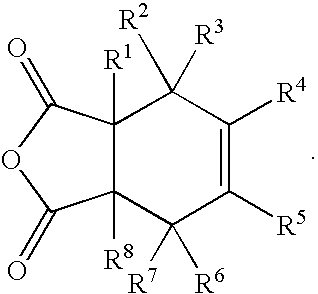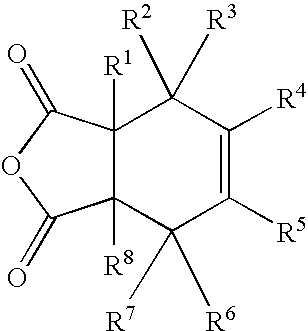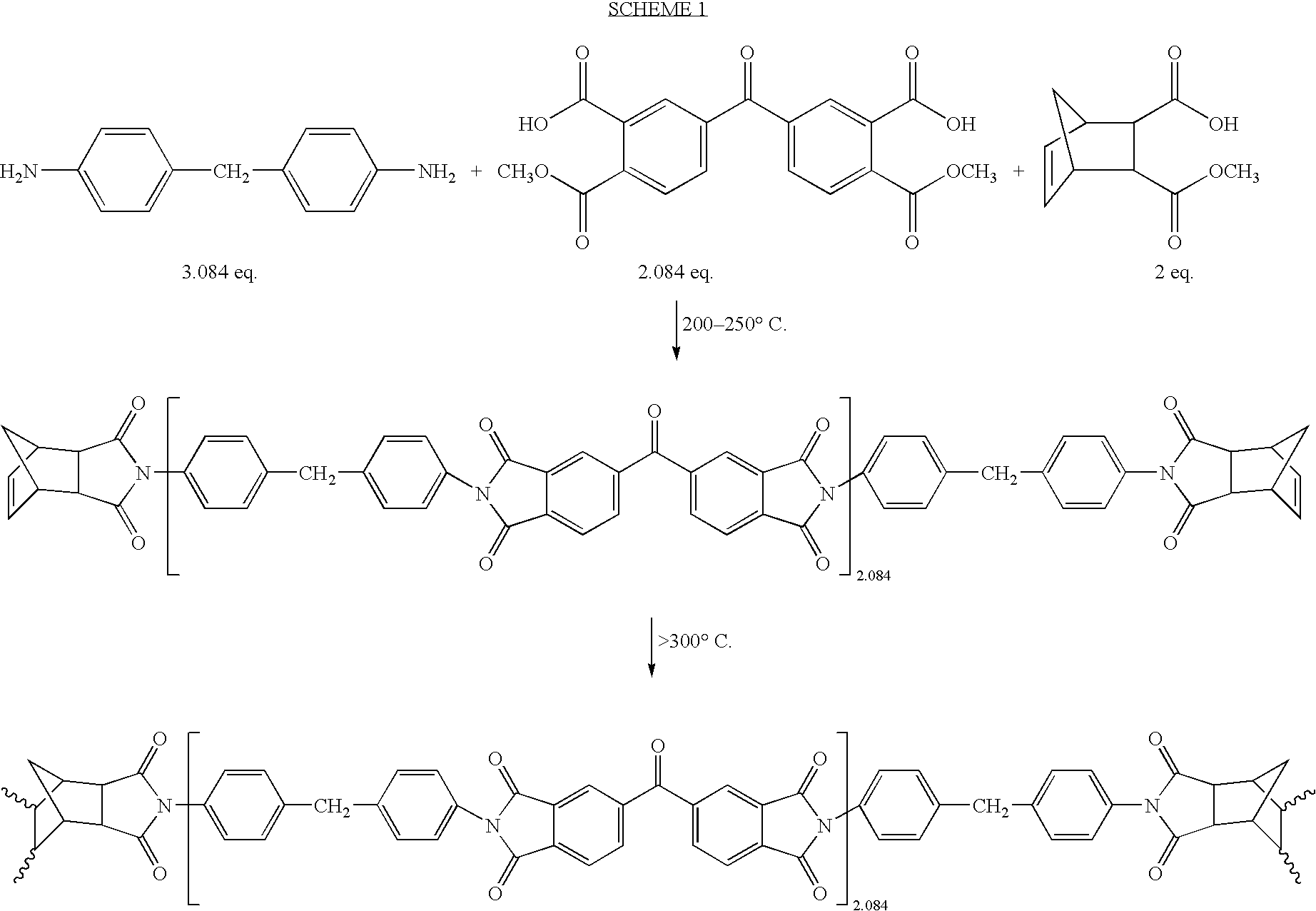Substituted cyclohexene endcaps for polymers with thermal-oxidative stability
a technology polyimides, which is applied in the direction of synthetic resin layered products, chemistry apparatus and processes, and can solve the problems of poor thermal-oxidative stability of norbornene end caps, limited use of most organic polymers, and inability to meet the requirements of cyclohexene end caps, etc., to achieve the effect of prolonging the life of pmr polyimides and not adversely affecting the processability of pmr composi
- Summary
- Abstract
- Description
- Claims
- Application Information
AI Technical Summary
Benefits of technology
Problems solved by technology
Method used
Image
Examples
example 1
[0089]Imidized 1500 molecular weight molding powders and crosslinked neat resin disk from 2,3-dimethy-1,2,3,6-tetrahydrophthalic anhydride (2,3-DMTHPA). 2,3-DMTHPA (3.60 g, 20 mmole), 3,3′4,4′-benzophenonetetracarboxylic dianhydride, BTDA (6.73 g, 20.87 mmole and 4,4′-methylenedianiline, MDA (6.12 g 30.87 mmole) were ground together with mortar and pestle to give an intimate mixture of the three monomers. The off-white powder was imidized in an air circulating oven at 200° C. for 1 hour followed by an additional half hour at 230° C. The yellow solid was finely ground with mortar and pestle to give a powder that was fully imidized, as evidenced by NMR and FT-IR. Compression molding at 345° C. for 2 hours gave a neat resin disk with good consolidation and low frangibility. NMR analysis revealed the THPA endcaps to be 100% cross-linked. The following illustrates the polymerization. Scheme 7 illustrates the polymerization.
example 2
[0090]Imidized 1500 molecular weight molding powders and crosslinked neat resin disk from 1,3-dimethy-1,2,3,6-tetrahydrophthalic anhydride (1,3-DMTHPA). 1,3-DMTHPA (3.60 g, 20 mmole), 3,3′4,4′-benzophenonetetracarboxylic dianhydride, BTDA (6.73 g, 20.87 mmole and 4,4′-methylenedianiline, MDA (6.12 g 30.87 mmole) were ground together with mortar and pestle to give an intimate mixture of the three monomers. The off-white powder was imidized in an air circulating oven at 200° C. for 1 hour followed by an additional half hour at 230° C. The yellow solid was finely ground with mortar and pestle to give a powder that was fully imidized, as evidenced by NMR and FT-IR. Compression molding at 345° C. for 2 hours gave a neat resin disk with good consolidation and low frangibility. NMR analysis revealed the THPA endcaps to be 100% cross-linked.
example 3
[0091]Imidized 1500 molecular weight molding powders and crosslinked neat resin disk from 3,3-dimethy-1,2,3,6-tetrahydrophthalic anhydride (3,3-DMTHPA). 3,3-DMTHPA (3.60 g, 20 mmole), 3,3′4,4′-benzophenonetetracarboxylic dianhydride, BTDA (6.73 g, 20.87 mmole and 4,4′-methylenedianiline, MDA (6.12 g 30.87 mmole) were ground together with mortar and pestle to give an intimate mixture of the three monomers. The off-white powder was imidized in an air circulating oven at 200° C. for 1 hour followed by an additional half hour at 230° C. The yellow solid was finely ground with mortar and pestle to give a powder that was fully imidized, as evidenced by NMR and FT-IR. Compression molding at 345° C. for 2 hours gave a neat resin disk with good consolidation and low frangibility. NMR analysis revealed the THPA endcaps to be 100% cross-linked.
[0092]The polyimides of this invention particularly underscore the importance of PMR resins to the aerospace industry and the benefits of using this nov...
PUM
| Property | Measurement | Unit |
|---|---|---|
| Temperature | aaaaa | aaaaa |
| Stability | aaaaa | aaaaa |
| Aromaticity | aaaaa | aaaaa |
Abstract
Description
Claims
Application Information
 Login to View More
Login to View More - R&D
- Intellectual Property
- Life Sciences
- Materials
- Tech Scout
- Unparalleled Data Quality
- Higher Quality Content
- 60% Fewer Hallucinations
Browse by: Latest US Patents, China's latest patents, Technical Efficacy Thesaurus, Application Domain, Technology Topic, Popular Technical Reports.
© 2025 PatSnap. All rights reserved.Legal|Privacy policy|Modern Slavery Act Transparency Statement|Sitemap|About US| Contact US: help@patsnap.com



